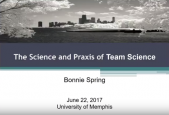- Downloadable & Interactive Tools
- Additional Resources & Tools
- Community Perspectives
- Glossary
- Suggested Books
- Suggested Articles
- Databases & Interest Groups & Conferences
Resources & Tools
Team Science Community Toolkit
Team Science Academic Modules
Welcome to the Team Science Resources and Tools page
Use the navigation on the left to browse many resources and tools related to Team Science. Scroll down to learn more about what is available in each section.

Team Science Community Toolkit
These resources and tools were designed with community organizations in mind; however, they are applicable to everyone. Go through Phases 1-5 of the toolkit to learn bout the 5 phases of a research project and context on how or when to use the tools.
Downloadable and Interactive Tools
Find all the downloadable tools and templates co-developed by community and academic partners. These tools can be downloaded and modified to fit your organization's needs. Will w Most of these tools will open in a new tab where you can download as individual tools. They can also be downloaded all together as a zip file.
Additional Resources & Tools
Explore helpful additional resources that are publicly available. These additional resources and tools were created by external parties and will open in a new tab.
Community Perspectives
Hear from some of the community partners who helped create this toolkit. They offer tips, advice, and lessons they have learned from their experiences with research.
Glossary
Find a list of key terms and phrases used throughout the Team Science Community Toolkit.

Team Science Academic Modules
These modules and resources were designed with researchers in mind; however, they are applicable to everyone. Go through the academic modules to learn how to promote Team Based Research, whether you're a new investigator, senior investigator, research development officer, or someone curious!
Suggested Books
Read about the Science of Team Science through suggested books and guides.
Suggested Articles
Read about the Science of Team Science through articles, including some of the foundational resources from the Team Science Academic Modules, and publicly available presentations.
Databases & Interest Groups & Conferences
Find resources and ways to engage with other people practicing and exploring the Science of Team Science.
Suggested Books
Read about the Science of Team Science
The Science of Team Science [SciTS] Mendeley group features a large library of literature on transdisciplinary research, as well as cross-disciplinary and inter-professional exchange of information and resources. Members can search resources in the database, create subgroups, and add resources and comments.
The Team Science Toolkit is a user-generated repository of information and other resources that supports the practice and study of team science. It contains over 1000 resources, including practical tools to support successful team-based research, measures and metrics to evaluate or study team science processes and outcomes, and bibliographic entries.
GUIDES
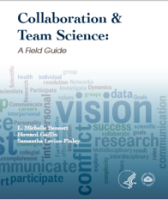
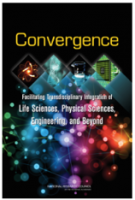
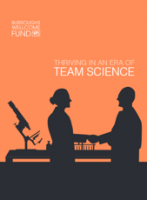
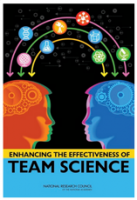
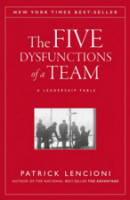
PRESENTATIONS
REFERENCES MENTIONED IN COALESCE MODULES
Contractor, N., Wasserman, S., & Faust, K. (2006). Testing multitheoretical, multilevel hypotheses about organizational networks: An analytic framework and empirical example. Academy of Management Review, 31(3), 691-703.
A look at various motivations for forming or joining a team and why people are motivated to create certain network links. There are several multi- theoretical motivations to create teams: individual, didactic, triatic, and group, and these can occur at multiple levels.
https://app.dimensions.ai/details/publication/pub.1072899281
Cummings, J. N., & Kiesler, S. (2007). Coordination costs and project outcomes in multi-university collaborations. Research Policy, 36(10), 1620-1634. doi: 10.1016/j.respol.2007.09.001
An overview of different coordination costs and their effect on project outcomes in multi-university collaborations.
Coordination costs and project outcomes in multi-university collaborations
Disis, M., & Slattery, J. (2010). The road we must take: Multidisciplinary team science. Science Translational Medicine, 2(22), 22. doi: 10.1126/scitranslmed.3000421
Defines multi-disciplinary team science and ways to successfully achieve it.
http://stm.sciencemag.org/content/2/22/22cm9.full
Guimerà, R., Uzzi, B., Spiro, J., & Amaral, L.A.N. (2005). Team assembly mechanisms determine collaboration network structure and team performance. Science, 308(5722), 697-702. doi: 10.1126/science.1106340
A description of how teams assemble and form specific collaboration structures and networks. This study examines how teams perform through collaboration.
http://www.sciencemag.org/cgi/content/long/308/5722/697
Jones, B., Wuchty, S., & Uzzi, B. (2008). Multi-university research teams: Shifting impact, geography, and stratification in science. Science, 322(5905), 1259-1262. doi: 10.1126/science.1158357
Teamwork in science increasingly spans university boundaries and all fields of science, engineering, and social science, due to a dramatic shift in knowledge production.
http://www.scienceonline.org/cgi/content/full/322/5905/1259
Shrum, W., Genuth, J., & Chompalov, I. (2007). Structures of scientific collaboration. Cambridge, MA: Massachusetts Institute of Technology Press.
Several different ways collaboration may be structured.
Structures of scientific collaboration
Stokols, D., Hall, K., Taylor, B., & Moser, R. (2008). The science of team science overview of the field and introduction to the supplement. American Journal of Preventive Medicine, 35(2), S77-S89.
First-annual conference examines different ways teams can organize, communicate, and conduct research.
The Science of Team Science
Wuchty, S., Jones, B., & Uzzi, B. (2007). The increasing dominance of teams in production of knowledge. Science, 316(5827), 1036-1039. doi: 10.1126/science.1136099
Outlines how a significant increase in teams has become dominant in the production of knowledge.
https://www.science.org/doi/10.1126/science.1136099
Databases & Interest Groups & Conferences
The Integration and Implementation Insights blog (also known as I2Insights) is a community weblog for researchers who are interested in Team Science and its use to facilitate understanding and acting on complex real-world problems. The blog is run by the Integration and Implementation Sciences team at The Australian National University.
Intereach (Interdisciplinary Integration Research Careers Hub) community brings together practitioners and researchers of interdisciplinary integration - people who connect across teams, disciplines, and sectors to solve problems requiring diverse expertise. Great space to share best practices, success metrics, and ideas for establishing intereach career paths.
NIH Biomedical Citizen Science Hub (CitSciBio) is a virtual collaboration space designed to help anyone interested in biomedical citizen science and crowdsourcing discover and contribute resources, form collaborative groups, and share expertise.
Interest Groups & Conferences
- Team Science Science of Team Science (SciTS)
- INGRoup
- The Association for Information Systems (AIS)
- International Transdisciplinarity Conference (td-net)
- NORDP
- Atlanta Conference on Science and Technology Policy
- Conference of the International Society for Scientometrics and Informetrics (ISSI)
- Sunbelt Social Networks Conference of the International Network for Social Network Analysis (INSNA)
- ACM CSCW
- HICSS (Collaboration Systems & Technologies; Organizational Systems & Technologies tracks)
- ProComm2017
- National Communication Association
- AOM
- SIOP
- American Evaluation Association
- American Public Health Association
- NSF EPSCoR
Suggested Articles
Savage N. How team science extends your scope. Nature. 2018;556(7700):S1-S3.
Lauer M. Impact of Teams Receiving NIH Funding. Open Mike. Vol 2018.https://nexus.od.nih.gov/all/2018/04/04/theres-no-i-in-team-assessing-impact-of-teams-receiving-nih-funding/ NIH; 2018.
Hall KL, Vogel AL, Huang GC, et al. The science of team science: A review of the empirical evidence and research gaps on collaboration in science. Am Psychol. 2018;73(4):532-548.
Fortunato S, Bergstrom CT, Borner K, et al. Science of science. Science. 2018;359(6379). The science of team science: A review of the empirical evidence and research gaps on collaboration in science
Fiore SM. The Strength in Numbers The New Science of Team Science. Science. 2018;359(6376):645-645.
Al-Suqri MN. Promoting interdisciplinarity in knowledge generation and problem solving. Hershey, PA: Information Science Reference; 2018.
Saunders P. Supporting researchers in an era of team science. Lancet. 2017;389 Suppl 1:S10-S12.
Little MM, St Hill CA, Ware KB, et al. Team science as interprofessional collaborative research practice: a systematic review of the science of team science literature. J Investig Med. 2017;65(1):15-22.
Klein JT, Falk-Krzesinski HJ. Interdisciplinary and collaborative work: Framing promotion and tenure practices and policies. Res Policy. 2017;46(6):1055-1061.
Khuri S, Wuchty S. Team science glossary. INTEGRATION AND IMPLEMENTATION INSIGHTS. i2insights.org/2017/03/16/team-science-glossary/2017
Fontanarosa P, Bauchner H, Flanagin A. Authorship and Team Science. Jama-J Am Med Assoc. 2017;318(24):2433-2437.
DeHart D. Team science: A qualitative study of benefits, challenges, and lessons learned. Soc Sci J. 2017;54(4):458-467.
Innovative assessment of collaboration. New York, NY: Springer Berlin Heidelberg; 2017.
Zeng XHT, Duch J, Sales-Pardo M, et al. Differences in Collaboration Patterns across Discipline, Career Stage, and Gender. Plos Biol. 2016;14(11).
Menken S, Keestra M. An Introduction to Interdisciplinary Research Theory and Practice Discussion and conclusion(s). Introduction to Interdisciplinary Research: Theory and Practice. 2016:96-100.
Leahey E. From Sole Investigator to Team Scientist: Trends in the Practice and Study of Research Collaboration. Annu Rev Sociol. 2016;42:81-100.
Van Noorden R. Interdisciplinary Research by the Numbers. Nature. 2015;525(7569):306-307.
National Research Council (U.S.). Committee on the Science of Team Science., Cooke NJ, Hilton ML, National Research Council (U.S.). Board on Behavioral Cognitive and Sensory Sciences, National Research Council (U.S.). Division of Behavioral and Social Sciences and Education. Enhancing the effectiveness of team science. Washington, D.C.: The National Academies Press; 2015.
Brown RR, Deletic A, Wong TH. Interdisciplinarity: How to catalyse collaboration. Nature. 2015;525(7569):315-317.
Bammer G. Interdisciplinarity: Less vague please. Nature. 2015;526(7574):506.
Glossary
- Active Listening
- Paying full attention to comments or conversations by showing interest through good eye contact, asking follow-up questions, and showing understand through feedback.
- Adverse Events
- Unexpected and/or unintended events that happen during a project that may have harmful or unfavorable results.
- Amendment
- A written description of change(s) to an ongoing, currently approved protocol. Amendments include any change to the study documents that affect scholarly intent, study design or human participant protection. Rationale for this/these change (s) should also be provided.
- Benefits
- Positive outcomes related to research, in other words - what was gained or improved from this experience. Examples include improving services and resources for the communities you serve, shaping/reforming policy, and personal benefits such as gaining additional analytical skill and building meaningful relationships.
- Binding Documents
- Documents that are legally enforceable. Agreeing to a legally binding contract/document means that you must follow/cannot stray from the guidelines listed in the document.
- Biosketch
- A biosketch is a brief resume presented in a specific format. It describes an individual’s qualifications and experiences.
- Boundary Setting
- Setting up conversation rules that indicate what can and cannot be discussed with different people. For example, some team members may not be asked to give their opinions on a job task or decision because they do not have the knowledge or experience to contribute.
- Budget Narrative
- A budget narrative describes the estimated costs of a budget. Sometimes called a Budget Justification, it explains and justifies why each item or category was included in the budget and how those costs were determined.
- Co-Developing
- Creating something with at least one other person in an equitable way.
- Collaboration Agreement
- A document that outlines the roles, responsibilities, timeline, expectations, and other important details of a study/project. A collaboration agreement is often updated as needed throughout a project, allowing for flexibility in project partnerships.
- Collaborative Institutional Training Initiative (CITI)
- CITI is a program designed to train people on various aspects of research. Human Subjects Protections Training (HSPT) is offered through CITI. If you are planning to publish or share/promote any information on your project/program, all team members must complete this training.
- Community Stakeholder
- People, groups, organizations, or businesses that have interest, concerns, and/or work in the community.
- Competent
- The mental ability of an adult to understand and comply with a research project or program. Vulnerable populations may not be considered competent to provide informed consent (e.g., minors, those with intellectual disabilities).
- Conditions
- Research conditions are general ways of describing positive or negative changes that may impact the quality of the data; program conditions are general ways of describing positive or negative changes that may impact the ability to run the program or run the program successfully.
- Confidentiality (vs Anonymity)
- Data is collected from research participants such that only the investigator(s) can identify the responses of individual participants. Participants personally identifying information is kept separate from other participant data collected.
- Conflict Transformation
- Taking a conflict, fight, or disagreement that has come up multiple times between people and focusing on, and fixing, why the conflict or fight keeps coming up. Conflict transformation means to change the reasons why people get upset in the first place.
- Contingency Plan
- Alternative or back up plans in case the first plan does not work the way it was intended, or new information arises to change course.
- Data
- Facts and statistics gathered and collected for reference and analysis. Data are the foundation of analysis and results. Types of data can include specimen (e.g., blood, bodily fluids), screenings or health testing (e.g., metabolic function, disease testing), and/or chart or electronic medical record (EMR).
- Data Analysis
- Statistical and other techniques to look for relationships between the information your participants provide. Data analysis usually is done when there is some question to be answered (e.g., does my health program change behavior?).
- Data Collection
- The process of gathering data. Collection can range from personal interviews, surveys, to physical experiments.
- Data De-Identification
- The process of preventing personal data from being revealed. In human subjects research, protecting the privacy of participants is essential. This would mean physically removing all information (e.g., names, emails, addresses) that allow someone from outside the study to know who any participants providing data are.
- Data Sharing
- Sharing data between organizations in a secure and methodical way.
- Data Storage
- Digital/physical data information securely stored in a way that can be found and used in the future.
- Data Use Agreement (DUA)
- A written contract between two or more organizations that outlines how sensitive data and information will be shared amongst them. A DUA is especially important when information that is being shared includes personal health information (PHI) or personally identifiable information (PII) like names, phone numbers, address, and more.
- Deviation from the Protocol
- Either not following or doing something outside of the study procedures as listed in the IRB-approved protocol.
- Direct Costs
- Dollars that are set aside for specific, countable items on a budget. These might include technical equipment like computers, employees, travel, giving participants some compensation for their time, and other material expenses.
- Dissemination
- The action of spreading information widely and sharing what you have learned from the study. In research, dissemination of findings and outcomes can be in the form of presentations, papers, and/or posters.
- Dissemination Plan
- The plan for how a team will share their findings and outcomes.
- Effort Percentage
- This represents the amount of time out of a person’s workweek that they spend on a specific project. Collaborates who work more hours a week will have a higher %effort.
- Eligibility
- The criteria for being selected to participate. For example, a study might be looking at women over the age of 65—in that case, individuals under the age of 65 and who do not identify as a woman would not be eligible to participate.
- Empathetic Communication
- Accepting and allowing different emotions or perspectives from people, while showing support and respect for these different emotions or perspectives. This usually involves active listening.
- Encryption
- Taking confidential or private information and adding extra layers of security over it before sending or transmitting it between individuals or institutions.
- Equitable
- A fair and proportionate distribution of responsibility. For example, splitting responsibilities 50/50 is equal, but it might not be equitable if an individual or organization does not have equal resources/capacity. A 60/40 split may be an example of a more equitable for an organization with differing resources/capacity.
- Executed Agreement
- A finalized agreement that has been signed by all parties.
- Feasibility
- Usually in reference to a study or program, this means how easy or difficult is it to create, run, and test a study or program. More feasible study/programs are easier to create and run; less feasible study/programs are harder to create and run.
- Financial Restrictions
- Limitations or specific requirements regarding how funds, policies, and/or activities may be used. Often determined by funders, organizations, or institutions.
- Findings
- Findings are the results or conclusions of your project, based on the data that were collected. Research findings answer your research question(s); sometimes they support or prove what you were testing, while other times findings disprove or challenge what you were testing. Findings come from data analysis.
- Fringe Costs
- Fringe costs are additional costs that cover employee benefits, such as health insurance, social security, worker’s compensation, and retirement. Organizations usually have a fixed percentage that they use.
- Funded Work
- Research or health programs that have been given a certain/specific amount of money from a person, institution, or organization other than the researcher or health program director.
- Funding Opportunity Announcement (FOA)
- Announces that funds are available for the public to apply for. Other names this might be called include - Request for Application (RFA), Notice of Funding Opportunity (NOFO), or Request for Proposals (RFPs). Regardless of what it’s called, FOAs always include the basic guidelines a funder wants applicants to follow in conducting research.
- Grant Announcement
- Announces that funds are available for the public to apply for. Other names this might be called include: Request for Application (RFA), Notice of Funding Opportunity (NOFO), or Request for Proposals (RFPs). Regardless of what it’s called, grant announcements always include the basic guidelines a funder wants applicants to follow in conducting research.
- Grant Period
- The total amount of months or years the research project has to be completed. Grant periods can run anywhere from 1 year to 5 years.
- Grant Proposal
- A formal, written application for funds to conduct a research project. Organizations that offer funding include government departments, corporations, foundations, or trusts.
- Grant Sponsor
- Manages/finances research projects.
- Health Insurance Portability & Accountability Act (HIPAA)
- The Health Insurance Portability & Accountability Act (HIPAA) protects the rights of individuals from companies and institutions who might otherwise share personal or sensitive health information.
- Human Subjects Protections (HSP)
- HSP is a collective term for the policies, procedures, and ethical considerations that protect the rights, welfare, and privacy of humans participating in research studies. Human Subjects Protections Training is required for all individuals involved in human subject research projects who come in contact with human participants and/or their identifiable data. A common program researchers/collaborators use to complete HSPT is the CITI program.
- Impact
- The overall effect your research has on different communities; whether that be improving community resources or helping other researchers formulate new ideas. Impact is often how benefit is measured.
- In-Kind Payments
- Paying a participant, organization, or other person using some non-money good or service. This might include with food for participants, with work for the organization, or with transportation cards for persons.
- Indirect Costs
- Payment to the organization running or involved in running a study or program for items not directly included in the research protocol but are seen as essential to complete a project. Indirect costs cover the organization’s rent of a workspace, their electric or other bills, administrative assistant support, and other items necessary to keep the organization running the study/program open for business. Similar to fringe, organizations use a fixed indirect rate that is multiplied by the direct costs and added to the amount of money requested.
- Informed Consent
- The specific description of a medical procedure, medical test, research study, or health program that explains the person’s rights, risks and benefits, and other important information to allow a person to make a competent and well-reasoned decision on participation.
- Institutional Review Board (IRB)
- The responsibility of the Institutional Review Board is to make sure proposed research projects are ethical—an IRB committee aims to protect participants, researchers, and the reputation of a research institution. Every university and health care facility that conducts research has an Institutional Review Board made up of experienced researchers. Your research project must be approved by the IRB before data can be collected.
- Letter of Support
- An official statement of intention and preliminary (early) support.
- Line-Item Budget
- A budget that presents proposed costs first in bigger categories like departments or cost centers, then broken down by a function or purpose.
- Materials
- Materials are the raw materials and tools you used in your project. The materials section of a formal research paper includes these tools, as well as your participant recruitment process, number of participants, participant demographics, ethical approval (IRB), and statistical methods used during data analysis.
- Memorandum of Understanding (MOU)
- Similar to a Collaboration Agreement, a Memorandum of Understanding (MOU) is a document that describes the responsibilities, roles, and expectations of the people and organizations involved in a project. It’s often updated as needed, allowing for flexibility in project partnerships. It is a non-financial collaboration agreement and is a good agreement to use if you would like to work or continue working with a partner but not exchange any funds.
- No-Cost Extension
- The extension of a project timeline without additional funding from your grant provider. If you decide that you need more time to complete the project, you can receive an extension, but no extra money to finish it. The funding for a no-cost extension comes from unused dollars from earlier in the grant.
- Open Budget
- A policy that emphasizes full transparency between the academic and community partner about what money the grant makes available, and how the proposed budget is distributed across partners.
- Participant Characteristics
- The number and type of study participants. This will help clarify who the findings apply to, as well as possible limitations. Participant characteristics describe the criteria or being able to participate or not participate in a study and why the criteria are important. It might include age, sex, ethnic or racial group, gender identity, education level, language preferences, and socio-economic status.
- Participant Communication
- The process of maintaining consistent and professional communication with those who have volunteered for your study. Participant communication can happen over email, text, phone calls, or other platforms that promote professional communications and have equitable access.
- Participant Consent
- Also called Informed Consent, this is the process of voluntary agreement by a fully informed person to participate in your research project. Participants have the complete power to choose whether they would like to be involved in the study after being given proper information about the risks and benefits involved. Participants also have the power to pull out of the study at any point with no penalty.
- Participant Enrollment
- Enrolled participants are individuals who are eligible to participate in your study, have given their consent to be a part in some or all of the study process, and have been given access to the research variables or health program materials or services.
- Participant Recruitment
- The process of finding people that are interested in becoming a study participant. Recruitment comes in many forms, such as social media, public advertisements, word-of-mouth, or canvassing.
- Project Period
- The period of time (timeline) for which the project must be completed. Project periods can range from a few months to years. The project period is proposed by the project team and is approved by the foundation providing your grant funding.
- Project Team
- The project team is a group of people working together on a project. It is made up of individuals from all the organizations involved on the project. The team members share responsibility for the outcomes of the project, set and follow the project timeline, and produce deliverables or products. Having clearly defined roles and expectations is critical to a successful Project Team.
- Protected Health Information (PHI)/Personally Identifiable Information (PII)
- PHI: Any health information protected by HIPAA (e.g., billing information from a doctor, emails to providers, health test results, medications); PII: any information that can allow for a person to be identified. PII can be a form of PHI in cases where names or email addresses can give away health information or health conditions.
- Recruitment Communication
- The approved methods of outreach to recruit participants (for example: phone calls, emails, text messages, social media). Any type of written message to potential participants including descriptions of financial or other rewards.
- Reflection Assessment
- A method to understanding and reflecting on how a partnership or project carried out. Completing a Reflection Assessment allows the project team to learn from their mistakes and celebrate their successes.
- Reflective Listening
- Responding to the thoughts and feelings you heard from your conversation partner. Reflective listening requires active listening.
- Regulatory Compliance
- Following the rules and regulations of research or programming governing boards or agencies. Not following such rules and regulations can have serious consequences that may lead to the shutting down of a study or even dismissal of employees.
- Reimbursement Model
- The method of giving money back to participants and researchers/collaborates for out-of-pocket expenses associated with participating in a research study, such as parking and/or transportation.
- Reproducibility
- Also known as replicability; The ability for findings to be consistent using the same data from the original study. If others can take your original study procedure, follow it exactly, and get the same results you did, then your study is reproducible. Reproducibility is a major principle of the scientific method and demonstrates that researchers used proper methods to get their results; their research can be trusted.
- Request for Application (RFA)
- Announces that funds are available for the public to apply for. Other names this might be called include: Funding Opportunity Announcement (FOA), Notice of Funding Opportunity (NOFO), or Request for Proposals (RFPs). Regardless of what it’s called, RFAs always include the basic guidelines a funder wants applicants to follow in conducting research.
- Research
- The systematic investigation of a question to establish facts and reach new conclusions. Research is done by using what may be known about an issue and building on it. Other knowledge can be found by proving (or disproving) existing fact and better explaining known observations.
- Research Protocol
- The detailed explanation of what will happen, step-by-step during the study or program, before, during, and after participant involvement.
- Responsible Conduct for Research (RCR)
- A philosophy that promotes quality science, collaboration, ethics, and cooperation through dissemination. RCR is usually taught to researchers, health providers and program managers through seminars and trainings. Having a certain number of hours may be a requirement of your funder or organization.
- Restrictions (funding)
- Limitations or specific requirements regarding how funds, policies, and/or activities may be used. Often determined by funders, organizations, or institutions.
- Scope of Work (SOW)
- An agreement that specifically describes the tasks and expectations that will be done on a project. The Scope of Work (SOW) can contain end goals, project milestones, reports, deliverables, timelines, communication and meeting frequency, and projected outcomes.
- Self-Advocacy
- Your ability to communicate and convey your wants, needs, and concerns to another person.
- Self-Awareness
- How a person consciously knows and understands their own character, feelings, motives, and desires and can include the ability to look at your own words and actions from a perspective outside of yourself; to see yourself as others see you.
- Self-Regulation
- The ability to monitor and manage your energy, emotions, thoughts, and behaviors in ways that are acceptable and produce effective results
- Study Aims
- Also known as specific aims, these are the key goals the study or health program is trying to accomplish through the creation and implementation of a research protocol.
- Study Ids
- A unique code made from letters and/or numbers that represent a study participant (rather than using their identifiable information). Study IDs are necessary to conduct longitudinal or follow-up studies or programs.
- Study Procedures
- The detailed explanation of what will happen, step-by-step during the study or program, before, during, and after participant involvement.
- Subcontract
- Subcontractors perform specific, significant duties and are essential to the completion of work. A subcontract is a legal document that outlines the details and expectations of the subcontractors. It usually includes legally binding information like payment processes and data use agreements (DUAs).
- Sustainability Plan
- Maps out how to achieve long term goals and describes ways to continue the program, activities, and partnerships.
A
B
C
D
E
F
G
H
I
L
M
N
O
P
R
S
Downloadable and Interactive Tools
Download the tools featured in the case scenario for personalization and use at any time or use these interactive tools to go through different scenarios and practice different communication strategies. Click the phase you would like to explore below:Introduction Phase
Phase 1 - Making the Decision to Partner
Relationship Considerations Checklist
Expectations and Responsibilities Checklist
Timeframe Considerations Checklist
Phase 2 - Co-Developing the Grant and Budget
Phase 3 - Preparing for the Research
Phase 4 - Conducting the Research
Phase 5 - After the Research is Finished
Team Communication Skill Building
Additional Tools for Community Toolkit
View helpful and publicly available tools featured in the case scenario, as well as additional resources related to Team Science and Community Engaged Research. All tools will open in a new tab. Click the phase you would like to explore below:Phase 1 - Making the Decision to Partner
Phase 2 - Co-Developing the Grant and Budget
Phase 3 - Preparing for the Research
University of Wisconsin - Team Science Collaboration Planning Resources
University of Wisconsin Collaboration Planning Template
Phase 4 - Conducting the Research
Phase 5 - After the Research is Finished
Team Communication Skill Building
Community Perspective Videos:
Click a image below to hear from Community Advisory Board Members about their experiences and lessons learned.
Introduction
The Team Science Community Toolkit was created by a group of Community and Academic Partners in Chicago, IL, USA. They created this toolkit to bring Team Science to community-academic partnerships. A primary goal is to increase equity and participation in community engaged research partnerships by addressing: The growing need for useful resources when participating in research projects and For all partners to feel informed and empowered to advocate for their needs and goals Hear from some of the community partners about why this was important to create.
The Gut Check Tool
When deciding about a request to partner, it's worth considering what your “gut” tells you. Don't be afraid to follow your intuition during this process and ask some “gut check” questions. Hear from a community partner about why the Gut Check Tool matters.
The Decision Calculator
Deciding whether to say yes to a new partnership can be difficult. Use the Decision Calculator to go through key areas that will help guide you in making this decision with your team. Hear from a community partner about why the Decision Calculator matters.
Developing the Grant Budget
Every project needs a budget and many also require a budget justification. Don’t be afraid to ask questions and advocate for what you need, especially when it comes to funding. Hear from a community partner about why co-developing a budget matters.
Applying For Grants
Preparing grant applications and working with funding agencies is a crucial step in a project. Stay organized and follow the Request for Application (RFA) in detail. Hear from a community partner about why the grant application process matters.
The Kickoff Meeting
A Kickoff allows the Project Team to come together and discuss goals, responsibilities, and details regarding the project. While each kickoff meeting might be different, they all should have some things in common, including getting everyone started on the same page. Hear from a community member about why a well-conducted Kickoff Meeting matters.
The Research Protocol
The research protocol requires an intense attention to detail. The protocol lists all the details of your project; read through it carefully and ask questions along the way. Hear from a community partner about why paying attention to the protocol details matter.
Communication Skills
Communication is key when collaborating with a partner organization. Reflect on and identify your own communication styles. What can both organizations do to support successful communication while collaborating? Hear from a community partner about why strong communication skills matter.
The Dissemination Plan
Developing an effective dissemination plan is critical to sharing your project. This is when all your hard work pays off and you get to see it in action. Hear from a community partner about why creating a strong dissemination plan matters.
